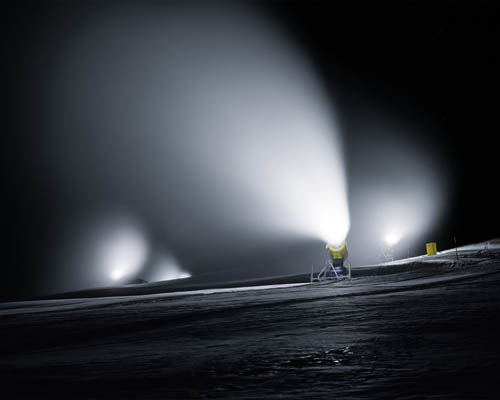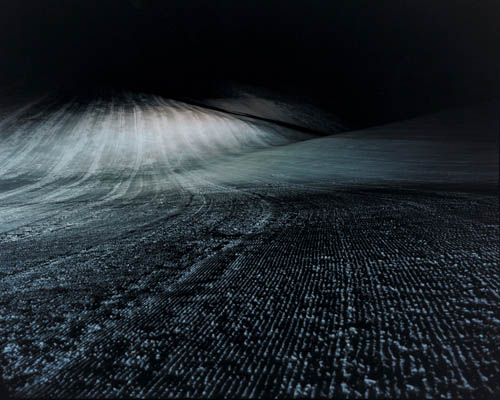Igneous Hydrology: Landscapes on Demand

[Image: "Scene J3" from Snow Management by Jules Spinatsch, courtesy of the Prix Prictet].
I was reminded, via an old post on Pruned, of an amazing series of photographs by Jules Spinatsch called Snow Management; Snow Management was deservedly short-listed in 2008 for the Prix Prictet.
With those images, Spinatsch documents the infrastructure of snow control—and outright terrain manufacture—at an Alpine resort, including the labyrinths of retaining fences and the individual pieces of equipment that make snow creation and large-scale, though ephemeral, landscape-sculpting possible.

[Image: "Scene D6" from Snow Management by Jules Spinatsch, courtesy of the Prix Prictet].
In a way, these scenes are like a big-budget variation on Sergio López-Piñeiro's idea, discovered via Mammoth, of a snow park or whitesward. López-Piñeiro's own photographic documentation of urban plowing practices—that is, the deliberate reshaping of snow piles into an ephemeral, new, seasonal topography—is an attempt, he writes, "to show how standard plowing techniques can become creative tools for generating winter landscapes." López-Piñeiro continues:
- The white parks that I envision could be easily constructed: plowing master plans would carefully locate the snow mounds, and the resulting designs would artistically exploit the spatial conditions defined by these usually overlooked piles of snow.
In winter, an artfully shaped snow landscape could become a “whitesward”—underscoring the now obscured potential for plowing to positively transform public space. Such a white landscape could be considered a “snow observation ground” to encourage people to appreciate the snow and its accumulation, and to dispel the negative impressions and experiences that our combative approach has produced.
More images from Jules Spinatsch's spectacular series are available on his website, and the Snow Management series itself can also be downloaded as a 3.2MB PDF.





Comments are moderated.
If it's not spam, it will appear here shortly!
Lately I've been closely following Vancouver Olympics' weather problems, namely the lack of snow, and this closing paragraph from the latest AP report caught my attention.
"According to the International Olympic Committee, the 1964 Innsbruck Games also faced a lack of snow. The Austrian army rushed to the rescue, carving out 20,000 blocks of ice from the mountainside and transporting it to the luge and bobsled tracks. They also carried 1.4 million cubic feet of snow to the Alpine ski slopes."
Post a Comment